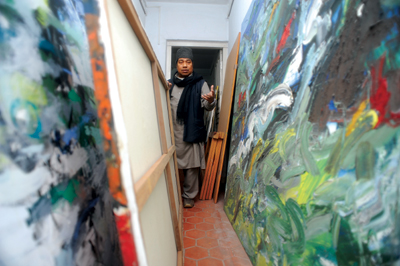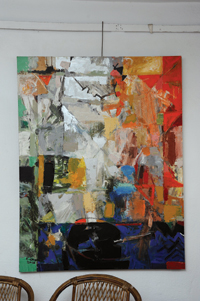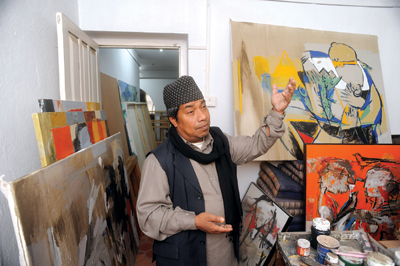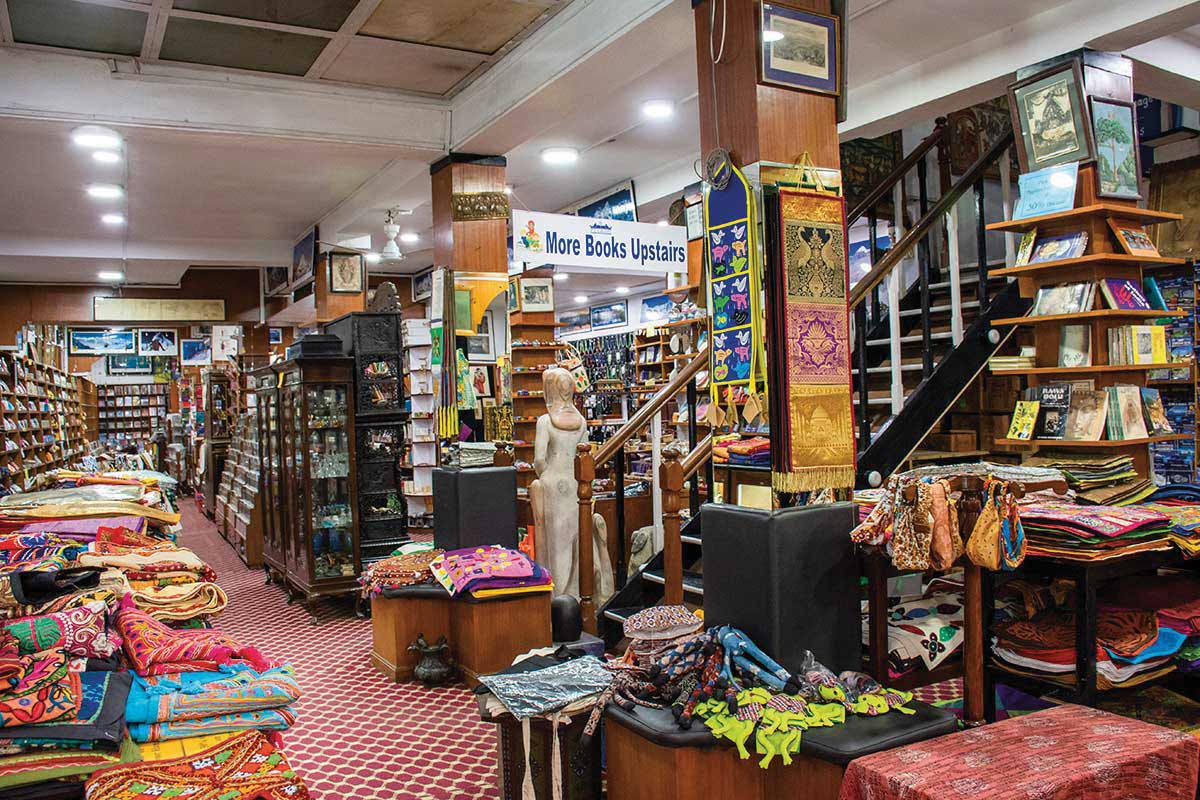An informal evening with Kiran Manandhar, Chancellor of Nepal Academy of Fine Arts turns into a reflective and introspective journey back in time.
For any Nepali painter, or an artist for that matter, Kiran Manandhar, the Chancellor of Nepal Academy of Fine Arts, is at the pinnacle of his career, heading the most prestigious body in the Nepali art scene.

The Chancellor of Nepal Academy of Fine Arts believes it is the country’s youth that will take Nepali art to new heights.
Had he not become a famous painter he would have become, well, a less famous painter. In his own words: “Even someone who would paint banners.” Manandhar fell in love very early on in life with his implements: pencils and eraser as a child and brushes and colors as he grew up.
The story of his life is nothing short of a melodrama in which he struggled with family members, teachers and society, but finally emerged victorious against all odds. That is because he himself, was never at odds with what he wanted in life. He had set a course for himself and developed a conviction right from his childhood that would not let him waver from this path.
“I can still feel the blood rush to the palm of my hand when I think of my mathematics teacher,” says Manandhar. “I was naughty and on top of that I was very poor in the subject.” After the teacher would teach something, he’d be asked about what he has just learnt. “I’d then hold up my notepad in which, instead of the sum, I’d have sketched the teacher’s figure, resembling a cartoon,” he says. “What would you expect? It was sketched by the wobbly hands of a kid.”
When Kiran returned home from school, his father admonished him for not being serious towards studies. His parents seldom let him sketch at home and snatched away his colors, papers or brushes if they ever found him fiddling with them. However, he continued to sketch at the then under-construction, water-garden in Balaju and in Nagarjun forest with material provided by his friends. “I’d mark myself present at school and head towards the jungle,” he says without a hint of guilt but with a certain glee. Of course he had a reason to be glad, for it was his mischief that brought him closer to the nature that inspired him and to people who would lay the ground work for his calling.
When ECS met Kiran Manandhar one recent evening, he spoke whole-artedly about Nepal’s art scene, the problems besieging it and what he, as a chancellor of Nepal Academy of Fine Arts, is doing to make things better.
 ART & NATURE
ART & NATURE
Natural instincts can be a major guiding force if we stay true to our nature. Especially, to an artist, nature is like a teacher. I cannot paint without sound. I catch the rhythm and carry on with the work. Every day I scatter some grains around the house and many pigeons and sparrows throng the house. I work as I listen to the sound of their chirpings.
Painting is like gardening. Just as a gardener maintains the beauty of his garden by throwing out weeds and unnecessary plants, a painter should be able to discard superfluous thoughts and elements.
For my colors, I seek out old houses built using bajra – the alternate building material used before cement was introduced to Nepal. The bajra crumbling out of decrepit buildings is dirt for most, for me it is color. I also go to rivers to find stones that have acquired a unique green color because of the river. I think we have to experiment with these things.
ART & SOCIETY
As I see, there are three main reasons why our art has not flourished. One, we were not free as a society for a long time. Two, our society until recently, considered painters as typists, who could only write invitation cards for weddings. Three, it has only been six months since an institution dedicated to promote art – the Lalit Kala Academy – has been established.
The situation is slightly better now and all of us should work to develop Nepali art. However, we should not follow what international artists are doing blindly. Instead, we should develop reflects our society and our culture. Modernization does not mean following what the world is doing.
There was Impressionism, Expressionism and Cubism in the West, so why can’t we develop something like, say ‘Mandalism’. A mandala captures an entire universe including the creator, the preserver and the destroyer. Again, other cultures within our society like Rais and Tharus and Maithili people they have their own expressions for any artist to take his cue and from which to develop a separate art form.
When I worked on the theme of a new mandala, I used different colours in place of traditional ones. Many senior artists rebuked the work but the logic was to take inspiration from our traditions and to create art that is relevant to present time. If we confine ourselves to following what has already been done, how can we belong to the present? We have to rethink and challenge our social values when time requires us to do so. It is a kind of sacrifice.
 INTERNATIONAL ART SCENE
INTERNATIONAL ART SCENE
There are five most developed places in terms of their art market and successful artists —New York, Paris, Germany, Tokyo and India. Even if we look at India, we have a great many things to learn.
If you talk about India and Europe, the government has made it mandatory for people to set aside 3 percent of construction costs for investment in the arts. They might invest on paintings, install a statue, help in the publication of a book or buy huge photographs. This lends a lot of support to the art community. They spend millions in construction and even if artists benefit by three percent of the investments, it is quite significant. Through this academy, (Nepal Academy of Fine Arts) we are trying to convince the government to have similar provisions in the new constitution.
If you notice the construction of houses today, even the simpler ones cost around 60 lakhs and then there are houses that cost more than a crore. It’s not like the people are poor here either; it is just that they are not art-conscious.
In India and other places, artists can mortgage their work to get loans. They are much ahead in terms of understanding the value of art. This support on top of getting great prices for their work is conducive for the development of an art scene.
ART & YOUTH
More than anything else, I vouch for the younger generation because they have the potential to change things and to take it forward. I tell this generation three things: that during the learning phase they have to be able to sacrifice. Forget about money and continue practicing until you attain perfection. Practice is important because whatever we learn gathers dust just like a mirror, no matter how many times you clean it.
As an art student in Benaras, I had days when I went hungry, was beaten by the police for sleeping at the railway station and had to sketch for money at the station as my family stopped sending money after they learnt that I was studying art instead of engineering. You have to sacrifice. There is a struggle in every work, but sacrifice brings maturity to it.
Secondly, young and aspiring artists must maintain good relations with senior artists to know the hows and the whys. They should also research about the art market and about artists, both national and international, to keep abreast of what is happening, and should read up on art too.
 INSTITUTIONALIZING ART
INSTITUTIONALIZING ART
The program I am trying to introduce is to make better arrangements for artist residence for foreign artists, publish a bulletin or an art magazine and forge alliances with foreign art institutions including those in the SAARC region to expand market exposure of our art. All this will help Nepali artists to be a part of an international fraternity of artists. This will help promote an exchange of ideas.
An artist cannot go far individually. The investment in material and publicity is so huge that they have to go through an institution. Another problem is that we do not have a standard mechanism for evaluating art. The prices, set arbitrarily, tend to vary. Exploitation of artists and buyers has great scope here, as there is a dearth of art critics and art dealers. Art critics have to be independent entities – people who are dedicated to studying and understanding art so that they can assign proper value to an artist’s work. Proper valuation is important for an artwork to be accepted internationally. In international markets, the buyers take art as investments, as assets - not just as a decorative item - and expect the price to go up. In European countries, the price of a piece goes up by 15 percent annually. However, if you sell an artwork for $ 50,000 to one person and for $10,000 to another, it will be a great loss to a buyer. Ultimately, it will set a negative impression about the art of a country. Knowing this is important.
We cannot ignore the earning aspect of an artist. It is also a profession and to expect an artist to work without caring about money or basic facilities is wrong. Artists have families too and they have to survive as well.
Take the case of the great painter Van Gough whose paintings sells for millions these days. He never saw wealth in his life; it was a sacrifice. A restaurant once famously threw away his paintings and the artist himself. Today, the same restaurant charges 25 Euros for a coffee that costs 6 Euros because of a painting by Van Gough protected by bulletproof glass hangs on a nearby wall.
However, you cannot expect an artist to receive remuneration for his work after his death. If an artist has accomplished something today, he should be paid today itself. Does Van Gough know that the world worships him for his works? Such a great artist had to die an unhappy man. That does not seem right, does it?










